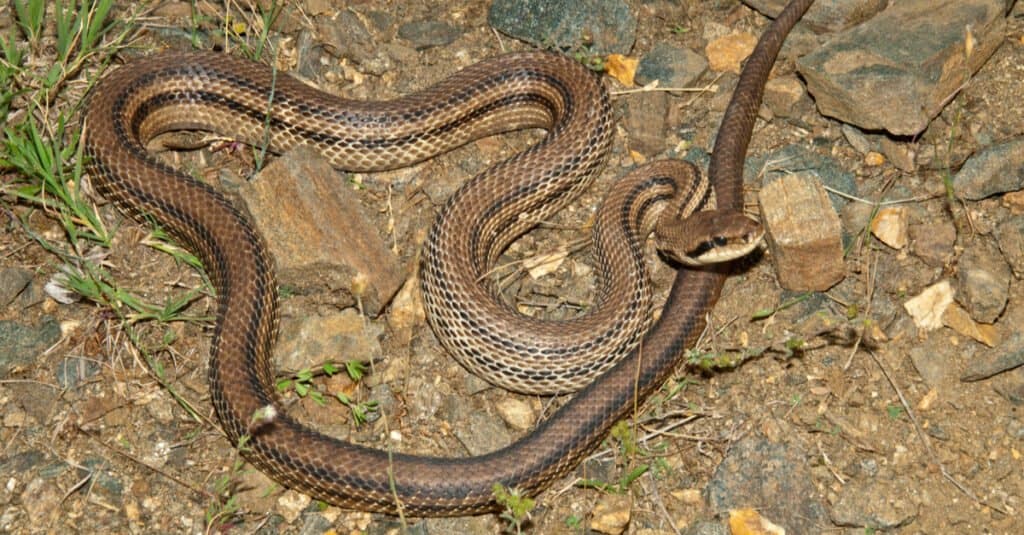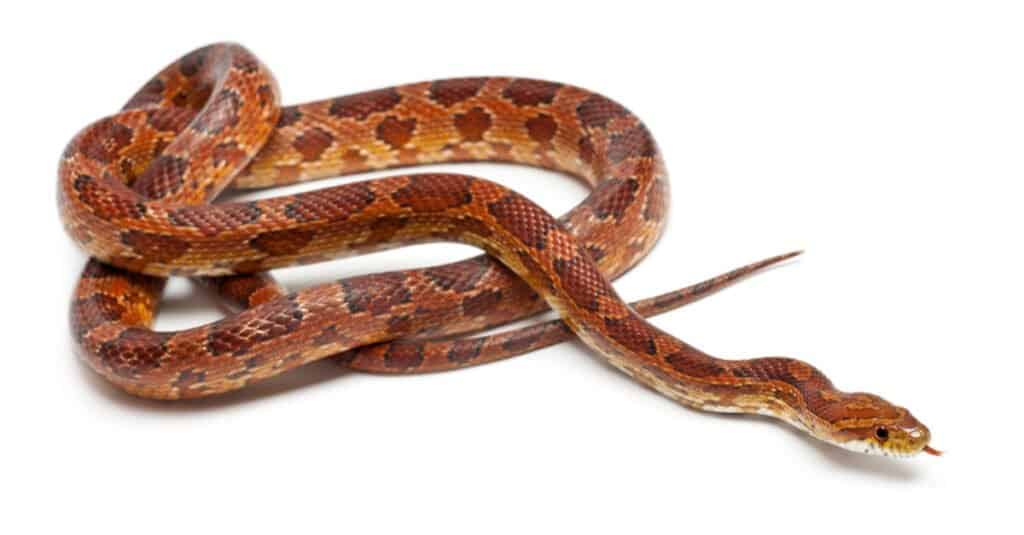Rat Snakes
.jumbotron {
background-image: url(“https://a-z-animals.com/media/2022/02/pantherophis-corn-snake-shutterstock_89927128-400×300.jpg”);
}
}
@media only screen and (min-width: 641px) and (max-width: 920px) {
.jumbotron {
background-image: url(“https://a-z-animals.com/media/2022/02/pantherophis-corn-snake-shutterstock_89927128-470×370.jpg”);
}
}
@media only screen and (min-width: 921px) {
.jumbotron {
background-image: url(“https://a-z-animals.com/media/2022/02/pantherophis-corn-snake-shutterstock_89927128.jpg”);
}
}
Rat Snakes
various
Rat snakes are constrictors from the Colubridae family of snakes.
Rat Snakes Scientific Classification
- Kingdom
- Animalia
- Phylum
- Chordata
- Class
- Reptilia
- Order
- Squamata
- Family
- Colubridae
- Genus
- various
- Scientific Name
- various
Read our Complete Guide to Classification of Animals.
Rat Snakes Conservation Status
Rat Snakes Facts
- Prey
- Rats, mice, birds, bird eggs, lizards
- Main Prey
- Rats and mice
- Name Of Young
- Hatchlings
- Group Behavior
-
- Solitary
- Fun Fact
- Rat snakes are constrictors from the Colubridae family of snakes.
- Biggest Threat
- Vehicles on roads, human encroachment
- Other Name(s)
- Corn snake, rat snake, bush snake,
- Gestation Period
- 2-3 months
- Temperament
- Generally mellow, but some species are more aggressive.
- Litter Size
- Anywhere from 3-20 eggs
- Habitat
- Dense rainforest jungles to arid deserts.
- Predators
- Birds of prey, other snakes, weasels, coyotes, badgers.
- Diet
- Carnivore
- Lifestyle
-
- Diurnal
- or Nocturnal Depending on Region and Season
- Number Of Species
- 50
- Average Clutch Size
- 12
- Nesting Location
- Hollow logs, leaf litter
Rat Snakes Physical Characteristics
This post may contain affiliate links to our partners like Chewy, Amazon, and others. Purchasing through these helps us further the A-Z Animals mission to educate about the world’s species..

Spiders that fly! Fish that walk! And 1000+ more incredible animals. Discover them all for FREE
.photo-gallery {
–margin: 0px auto 0px;
–padding: 0px 0px 0px 0px;
}
.gallery-link {
background-image: url(“https://a-z-animals.com/media/2022/02/Gonyosoma-rhino-ratsnake-shutterstock_1655668984-1024×535.jpg”);
background-repeat: no-repeat;
background-size: cover;
background-position: center;
height: 500px;
justify-content: center;
text-align: center;
align-items: center;
display: flex;
border: 2px solid #000;
}
.gallery-link img {
height: 50%;
}
@media only screen and (max-width: 768px) {
.gallery-link {
height: 300px !important;
}
}
View all of the Rat Snakes images!
Rat snakes live in a wide range of environments.
There are roughly 50 rat snake species spread across 15 genera; they’re non-venomous and helpful garden allies. You can find them in most parts of the Northern Hemisphere, and they come in a variety of colors and patterns. They’re all oviparous and lay eggs in hollow tree stumps and quiet corners full of leaf litter; they’re also not typically aggressive.
Like the Rhinoceros snake (G. boulengeri), some sport a bright green color and a rhino-like nose; others, like the Eastern fox snake (P gloydi), are more discreet; they sport a shield pattern on their backside. These varied and adaptable snakes live in a wide range of environments.
Rat snakes are terrific climbers. Most species spend a significant amount of time in trees, on the tops of buildings, and in and around the rafters looking for their next meal. The joke about these snakes in some areas is that it’s probably a rat snake if it got into a weird place.
4 Amazing Facts About Rat Snakes
- There are over 50 pecies, spread across most of the Northern Hemisphere.
- Some species can exceed 9 feet long.
- They get their name from their favorite prey: rats and mice.
- New World species are more closely related to king snakes than they are to the Old World rat snake species.
Where to Find Rat Snakes
These snakes are widespread; most areas of the Northern Hemisphere host at least a few of these snakes. They live in various habitats, including dense rainforests, semi-arid fields and farmland, and arid deserts. Rat snakes are regularly found in odd places, like the eaves of a roof or climbing up a brick wall. They are excellent climbers, and they often climb trees, fences, and other obstacles to get to their meal.
They’re active daytime (diurnal) hunters and eat a variety of rodents, including rats, mice, and even squirrels and chipmunks. Juveniles will sometimes eat lizards, but the adults almost exclusively prefer warm-blooded prey.
Most rat snake species have adapted well to humans, and many are found on the hunt, slithering around the edges of homes and buildings.
Read here to find out about rat snakes in Florida. You can also read here to find out about three rat snakes in Georgia.
Rat Snake’s Scientific Name
Rat snakes are a large group of snakes from the suborder Colubrinae in the family Colubridae. Colubridae is the largest family of snakes; its members make up approximately 75% of all snake species. Some species were reclassified from Elaphe to other genera in recent years, including Pantherophis, Orthiophis, Zamenis, and others.
Until the early 2000s, scientists lumped most of them into the Elaphe genus because they believed they were all closely related. However, when they did DNA analysis of several Old and New World species, they discovered it was more complicated than they realized. The Old and New World species aren’t all that closely related, and in fact, the New World rat snakes are more closely related to kingsnakes than the Old World rat snakes.
It gets better – not all the groups that research and name reptiles agree. For example, in 2002, herpetologist Urs Tiger suggested renaming most North American species Pantherophis, the Global Biodiversity Information Facility (GBIF), and the Society for the Study of Amphibians and Reptiles (SSAR) agreed; they now recognize Pantherophis. However, International Commission on Zoological Nomenclature (ICZN) and the Convention on International Trade in Endangered Species (CITES) don’t appear to, but those things can and do change.
Types of Rat Snakes
There are approximately 50 species of these harmless reptiles. The Old World species inhabit Europe & Asia, while the New World species inhabit the Americas. They’re primarily arboreal and have a wide variety of patterns – they can be blotchy or striped, or solid-colored. A few have long pointy noses, and some are multi-colored.
Old World Group
This group of rat snakes lives in most places in the Eurasian continent and into Southeast Asia.
Coelognathus
Snakes in this genus inhabit areas of Southeast Asia. It includes the Philippine rat snake (C. erythrurus), yellow striped snake (C. flavolineatus), trinket snake (C. helena), copperhead rat snake (C. radiatus), and the Indonesian rat snake (C. subradiatus).
Elaphe
The Elaphe genus includes the Twin-spotted rat snake (E. bimaculata), King rat snake (E. carinata), Japanese rat snake (E. climacophora), David’s rat snake (E. davidi), Dione rat snake (E. dione), Japanese four-lined rat snake (E. quadrivirgata), the Four-lined snake (E. quatuorlineata), Red-backed rat snake (E. rufodorsata), Eastern four-lined snake (E. automates), and Russian rat snake (E. schrenckii).
Euprepiophis
These snakes occur in Japan and China. The genus includes the Japanese forest rat snake (E. conspicillatus) and China’s pearl-banded rat snake (E. perlacea). The Mandarin rat snake’s range includes China, India, Myanmar, and Taiwan.
Gonyosoma
They inhabit areas of China, India, Southeast Asia, Malaysia, and Indonesia. This genus displays a wide variety of colors, and some sport a rhino-like horn on the tip of their nose. This genus includes the Assam trinket snake (G. frenatum), Celebes black-tailed rat snake (G. jansenii), Red-tailed rat snake (G. oxycephalm), blue-eyed bush rat snake (G. coeruleum), rhinoceros snake (G. boulengeri), Hainan rhinoceros snake (G. hainanense), rainbow tree snake (G. margaritatum), and green trinket snake (G. prasinum).
Oreocryptophis porphyracea
This is another Southeast Asian species. Mountain rat snakes are the only species in Oreocryptophis.
Orthriophis
includes Cantor’s rat snake (O. cantoris), Hodgson’s rat snake (O. hodgsoni), the Chinese beauty snake (O. taeniurus), and the flower snake (O. moellendorffi). They inhabit China and Southeast Asia.
Ptyas
is a Southeast Asian genus. It includes the keeled rat snake (P. carinata), Sulawesi black racer (P. dipsas), the white-bellied rat snake (P. fusca), Chinese rat snake (P. korros), Oriental rat snake (P. mucosa), green rat snake (P. nigromarginata), P. dhumnades, and P. luzonensis. They’re also called giant rat snakes due to their size; they can grow over nine feet long.
Rhadinophis prasinus
Green bush snakes are bright green, and range from 3 to 4 feet long. They inhabit areas of Burma, China, India, Malaysia, Thailand, and Vietnam.
Zamenis
Snakes in this genus inhabit Europe and the Middle East. Their genus name, Zamenis, comes from Greek and means angry. They tend towards aggressively defending themselves, and some say they have a relatively short fuse. They include the Transcaucasian rat snake (Z. hohenackeri), Italian Aesculapian rat snake (Z. longissimus), Italian Aesculapian rat snake (Z. lineatus), Persian rat snake (Z. persicus), ladder snake (Z. scalaris), and leopard snake (Z. situla).
New World Group
Bogertophis
The desert rat snakes inhabit areas of the Southwest United States and northern Mexico. The Baja California rat snake (B. rosaliae) and Trans-Pecos rat snake (B. subocularis) inhabit various habitats ranging from forested areas to deserts.
Pantherophis
The majority of snakes in the New World group are Pantherophis. The genus includes the Eastern rat snake (P. alleghaniensis), Baird’s rat snake (P. bairdi), Great plains rat snake (P. emoryi), Eastern fox snake (P. gloydi), Western fox snake (P. ramspotti), Corn snake (P. guttatus), black rat snake (P. obsoletus), Slowinski’s corn snake (P. slowinskii), and gray rat snake (P. spiloides).
Pseudelephe
There are two Mexican species, the yellow-red rat snake (P. flavirufa) and Yucatan rat snake (P. phaescens). Both species inhabit Yucatan, but the yellow-red rat snake also occurs in Eastern Mexico, Belize, Guatemala, Honduras, and Nicaragua.
Senticolis
Green rat snakes (S. triaspis) inhabit many western areas of Central America.
Spilotes
Spilotes is a single-species genus and the chicken, or yellow rat, snake (S. pullatus), occurs from Eastern Mexico into South America in southern Brazil, southeastern Paraguay, and northeastern Argentina.
Rat Snakes: Population and Conservation
There are a few listed on IUCN Redlist as vulnerable or endangered, such as the cave racer (E. Teniura) and pearl-banded rat snake in China (E. perlacea). Still, the IUCN Redlist says that most species have stable populations. However, many aren’t on the list because there isn’t enough information.
Many animals prey on rat snakes, including weasels, badgers, birds of prey, coyotes, and other snakes. Their main threat varies depending upon where they live. Human encroachment can be an issue, but more often, it’s vehicle encounters and illegal harvesting of the snakes for the pet trade. In some areas, weather such as a hurricane is a threat because of the flooding caused by the storms.
Identifying Rat Snakes: Appearance & Description
These snakes are medium to large, sometimes very long, somewhat slender. They are constrictors from the Colubridae family and kill their prey by grabbing onto it and suffocating it. They range in length from 3 feet to over 9 feet long, and their favorite pastime seems to be getting into odd positions that defy logic. For example, people routinely find a rat snake wedged into the grout lines of bricks as it makes its way from one place to another. They can’t grab onto the bricks like a lizard can, so they wedge themselves into cracks and crevices using their belly scales as leverage for movement.
In most species, their heads are turtle-shaped, some have what looks like a ghost in the pattern on the tops of their heads, and many have a lighter background color with darker shield-shaped patterns down the length of their backs. Of course, not all have these features, but enough of them make identifying them easier.
Rat Snakes Pictures and Videos

Sibons photography/Shutterstock.com

imageBROKER.com/Shutterstock.com

Blue Dog Studio/Shutterstock.com

Eric Isselee/Shutterstock.com

Eric Isselee/Shutterstock.com
How Dangerous are Rat Snakes
These aren’t dangerous to humans. However, some snakes in the Old World group have very mild venom in their mouths that does not affect people or dogs; none of them have fangs to inject any venom. A few of the larger species can deliver a painful bite because they have strong jaws.
Sometimes rat snakes will get into chicken coops and eat the eggs and chicks, so some people aren’t excited about seeing one. They can get very long, so they sometimes look dangerous, but they’re harmless.
Rat Snake Behavior and Humans
Many species have adapted well to humans and hide out under houses, in attics, and around yards. Rat snakes are active daytime hunters. However, some are flexible, so they also hunt in the early evening and morning hours.
If you find one in your garage, there’s nothing to fear. Rat snakes are appropriately named; they eat rats and mice that cause damage. Unfortunately, they also eat chicken eggs and chicks if they can. They may also frighten you by poking their heads out from some crevice above your head.
If you startle one, it will rattle its tail against something to make some noise imitating a rattlesnake, and it may bite, but unless it’s a giant rat snake, it probably won’t hurt very much and will only need a little basic first aid.
View all 74 animals that start with R
Rat Snakes FAQs (Frequently Asked Questions)
Are rat snakes venomous?
They’re not dangerous to humans and are non-venomous. Some Old World rat snakes have a small amount of weak venom that doesn’t affect humans or dogs, but they have no fangs and cannot inject it.
How do rat snakes hunt?
Most rat snakes are primarily arboreal and cruise through the trees hunting for their prey.
Are rat snakes aggressive?
Not generally, but some people consider Old World rat snakes more cranky than New World rat snakes.
Where do rat snakes live?
They’re pretty widespread! Rat snakes inhabit most areas in the Northern Hemisphere.
What do rat snakes eat?
They’ll eat lizards, birds, and bird eggs, but most prefer mammals like rats and mice.
Sources
- Michigan State University | Natural Features Inventory, Available here: https://mnfi.anr.msu.edu/species/description/11505/Pantherophis-gloydi
- Smithsonian National Zoo, Available here: https://nationalzoo.si.edu/animals/corn-snake
- Maryland Zoo, Available here: https://www.marylandzoo.org/animal/black-rat-snake/
- Reptile Database, Available here: https://reptile-database.reptarium.cz/
- RepFocus.dk, Available here: https://repfocus.dk/Euprepiophis.html
- Research Gate, Available here: https://www.researchgate.net/publication/353064305_A_new_snake_species_of_the_genus_Gonyosoma_Wagler_1828_Serpentes_Colubridae_from_Hainan_Island_China
- Thai National Parks, Available here: https://www.thainationalparks.com/species/ptyas-fusca
















